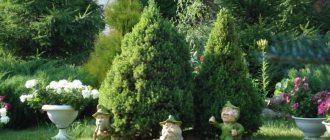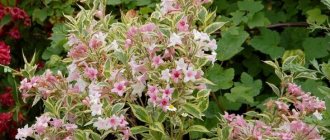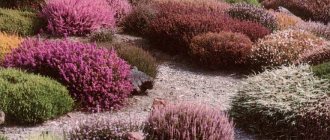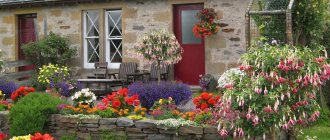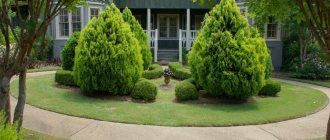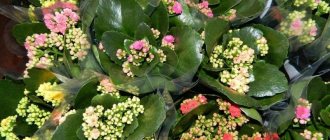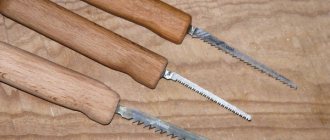Progress does not stand still. The same applies to garden plots. Dachas are transformed into stylish cottages with enviable landscaping. Receiving a harvest is no longer the primary reason for coming to the dacha. The site turns into a recreation area, both physical and moral. And the best way to relax is with a view of the colorful landscape. The main assistant in creating unsurpassed views are lawns, ornamental trees and shrubs. We will talk about them in this article.
In addition to the aesthetic function for which ornamental plants are so loved, they also perform others. For example, a properly designed area may visually appear larger than it actually is. Outbuildings can take on an outlandish appearance or become part of a landscape solution, and not something that you want to hide from human eyes. Trees with strong roots can help stabilize sloping areas and embankments. In an open space, decorative vegetation can replace “walls”, zoning the space, or act as a fence, making your area more secluded.
Ornamental trees and shrubs: what to choose?
Those types of ornamental trees that do not require a lot of effort in physical and material care are in particular demand. They may not be very practical, but they are beautiful and not whimsical. These include standard trees; they do not take up much space and their crown has a spherical shape. Columnar hybrids, weeping and dwarf species of fruit and forest trees are also very popular. Forest trees have become a real sensation in the design of fences and walls.
The lawn landscaping scheme consists of trees with a noticeable difference in height. The tallest ones create a background that harmonizes with the shorter trees and shrubs. Miniature or bright ones make up the foreground. They can be either free-standing or combined with other tiers, building a complete picture.
The unsurpassed leader among the most unpretentious plants is coniferous trees. They require almost no maintenance, while maintaining a presentable appearance all year round. Some species take on a look reminiscent of Christmas trees decorated with toys during the flowering period. And overall they look smart. Spruce is well suited for swampy soils, and pine will take root in places with arid climates. A separate advantage will be the fact that it will not be difficult for you to maintain the required height and shape of the plant. Yew has similar properties. It is easy to make hedges from and maintain their appearance.
Functions in landscape design
Before you can narrow down your tree selection, determine why you are planting the tree. Here are some of the most common reasons why trees are planted in the home landscape.
- Shade: Want to add shade to your yard? Choose a tree with a wide crown that will cast a lot of shade.
- Beauty: If you want to enhance the curb appeal of your borders, consider planting something with a bright color or unique texture. Decorative flowering trees are a great start.
- Food. Picking your own fruit is great fun. And you don't have to wait 10 years to reap the benefits. Many fruit trees are dwarf varieties and can bear fruit in just 3-5 years.
- Confidentiality. Trees work well as privacy shields and soften harsh landscapes. Plus, they last longer and are cheaper than installing a traditional fence. With so many fast-growing tree options, it's hard not to add more greenery to your yard.
- Habitat: Wildlife provision is a surefire way to bring life to any landscape. Be it birds or squirrels, there is a tree for every creature.
Ornamental trees and shrubs: Arborvitae
There are a great many varieties of thuja; everyone can find the type that suits them. They come in different shapes (spherical, pyromidal). Each strip has its own thuja, which will take root in the appropriate climate. The only thing that unites all species is a love of showering and spraying.
Magnolia
You should purchase magnolia from a nursery or garden center. Only there they will sell you a seedling with a root ball. Choose your planting site carefully. Be careful not to damage the roots. The soil should not be calcareous, the best solution
will acidify it with peat. While the sprouts are very young, cover the roots with mulch for the winter and the crown with agrofibre. Magnolia does not like drafts and wind, but enjoys bathing in the rays of the sun. An adult plant should undergo sanitary pruning periodically. There are many hybridomas and different forms of magnolia, choose one that will tolerate the climate of your latitude. This exotic curiosity can grow in the form of a bush or a slender tree with a luxurious crown. During flowering, it mainly has a pleasant vanilla-citrus aroma.
Gardening for spring
Magnolia trees
Spring is for flowers. When the snow recedes and life returns, you need color, lots of color. This is one reason you can forgive this glorious tree for being only a spring wonder. Its critics note that it is of no use beyond the short period of the spring season when it blooms.
But nothing adds color like flowers, be they annuals, perennials, shrubs or trees. Any landscaped yard will have at least one flowering landscape tree of exceptional beauty.
Magnolia trees (Magnolia spp.) are some of the most spectacular specimens. Star magnolias often bloom earlier, while saucer magnolias bloom more heavily.
Apple trees
You don't have to be a farmer to grow apple trees (Malus spp.) in your yard. It's more than just fruit. Apple trees themselves have beautiful flowers. Fruit is already a bonus. If you don't care about growing edible fruit, apples will serve your purposes better.
A variety with rose-red flowers that reaches a height of 6 to 7 meters is Malus x Centzam or Centurion, which can be grown in almost any climate zone.
Dogwood trees
You'll probably want more than just flowering landscape trees that create a floral extravaganza in the spring. Luckily, sometimes in landscaping you get a two-for-one bonus.
In this case, these are dogwood trees (Cornus florida and Cornus kousa). They are unique in their capabilities: blooms in the spring, vibrant foliage in the fall, berries to attract wild birds in the winter, and interesting branching patterns year-round.
Sakura
Unlike magnolia, sakura does not have to be purchased as a seedling. If you grow traditional cherries or sweet cherries, you can graft the plant onto them using the budding method. It will be cheaper, but no worse. All other care is very similar to that described in the chapter above. It should also be sprayed against pests, watered abundantly, the crown cared for, and pruned. As a gift, this Japanese relative of the cherry will give you the world-famous flowering period.
Beautiful and fruitful
Instead of the familiar apple tree, you can acquire a decorative subspecies or its weeping form. Colorful fruits and flowering branches with bright and variegated leaves attract birds to the garden, which is a natural solution to pest problems. The fruits make exotic jam. For example, the Ola apple tree blooms with large scarlet flowers that completely cover the branches.
Caring for such trees will become familiar. It differs little from the familiar actions using agricultural technology used to care for traditional apple trees.
Options for low growing trees
Low-growing trees form the front composition of the garden, so it is important not to go wrong with the choice of vegetation that will be the first to attract attention. One of the beautiful trees is the warty birch. It has hanging branches with light, lacy foliage. Such a tree will slowly increase in size and reach its maximum size of five meters approximately twenty years after planting.
Warty birch can withstand low temperatures and dry conditions, but prefers good light.
You can also place Paul Scarlet hawthorn in the garden. These small ornamental trees have delicate pink blooms in May and June. Hawthorn rarely bears fruit. Such a plant can be trimmed and decorated in different shapes so that the garden impresses not only with its color scheme, but also with its geometry.
Tip: in the winter season, cover the prickly hawthorn to protect it from the cold.
We recommend paying attention to evergreen ornamental trees, which will decorate the natural corner of your summer cottage in any season. Small trees of this type include Daurian juniper. It has thick branches with needles and grows up to 1.5 meters. But the width of such a plant can be about three meters, so with the help of juniper you will decorate large areas. This decorative tree looks original even in a pot.
High and low temperatures do not have a negative impact on these trees, and constant care is not needed to maintain their beauty.
Dwarf ornamental trees for the garden can be chosen at the same time as flowers and bushes. In this case, you will be 100% sure that the landscape design will look harmonious.
Ornamental trees and shrubs: Junipers
There are too many shrubs to generalize or talk about each individually. Below we will look at the most popular types of junipers. In general, they complement the overall composition, serve as undergrowth, or are present primarily for eye candy, while purifying the air. When given enough sunlight or heat, the plant releases an aroma with healing properties. Because of this, young twigs are often added to bath brooms. Another advantage of junipers is that they are frost-resistant.
Hedge
A hedge is a dense wall of bushes planted instead of a fence or framing other plantings on the site. For hedges, you need to choose shrubs that tolerate pruning well. A high hedge will be made from varieties of small-leaved elm, juniper, thorn, thuja, and barberry. Currants, small-leaved linden, boxwood, cinquefoil, yew, and bladderwort are suitable for decorating low-growing plants.
Fan maple in the garden
Ornamental trees and shrubs: Barberry
Barberries should be placed in an open area with plenty of sunlight. A drainage pad will not be superfluous. Reacts poorly to stagnant groundwater. Otherwise, no special conditions will have to be provided to the soil.
The bushes have an intricate shape with colorful foliage in muted shades. Peak flowering occurs in spring. The color palette is quite diverse: lilac, red, light green, purple, lemon, wine, etc. you can even harvest your crops. Barberry berries are used as a seasoning for meat and pilaf.
Bushes will look advantageous as individual elements or part of the overall picture. The choice of all colors and varieties allows you to choose the most advantageous option. Depending on the type, the height of barberry can vary from 25 to 150 centimeters.
Curly trimming of bushes - topiary
Topiary is the ancient art of cutting bushes. A skilled gardener can give a shrub any shape: an animal, a bird, a geometric figure. Mastering this art is quite difficult; in addition to patience, artistic skills are required. But the resulting figured bush will be a unique element of garden design. Although it is still better to entrust complex work to professionals. You can trim the hedge yourself evenly, following the stretched ropes as a guide, then try to give the fast-growing shrub simple shapes of a ball, hemisphere, or oval.
Apple trees in the garden
For experiments, you can plant such shrubs as noble laurel, western thuja, yew, cypress, barberry, privet, and common boxwood.
From the rich variety of plants, you can create any garden to your liking in a large or small area. If all the plants are correctly selected, located and surrounded by your care, any garden will be beautiful - fruit, ornamental or mixed.
Jasmine in the garden
Red viburnum
This is a shrub familiar to us, but this does not negate its attractiveness and the benefits of its berries. Viburnum prefers shade and can grow strongly in such conditions. Looks good as a decoration for the walls of buildings where there is no access to the sun. Bright clusters on the branches and crimson-yellow leaves will add color to such places and will not lose their beauty and strength. The main thing is to water the bush abundantly and do not spare the humus when planting. Later, the ground should be covered with tree bark mulch so that moisture from the roots does not evaporate.
Garden style
You also need to decide on the style of the future garden. He can be:
- regular - it is distinguished by even rows of neatly trimmed trees, well-thought-out landscape design;
- landscape looks as if all the vegetation has grown on its own.
In order to get a natural effect, you need to work hard, carefully thinking about how to place trees in the garden.
Maple in the garden at home
Decorative shrubs in the garden
Ornamental trees and shrubs: Garden hydrangea
Hydrangea absorbs a lot of sunlight, but should not be planted in direct sunlight. The soil should be slightly acidic with additional fertilizing, peat, sand and coniferous forest soil. The bushes should be watered abundantly with acidified water; if desired, you can achieve a bright blue color by adding iron elements to the water. Around the roots you should mulch with pine needles. Frosts are poorly tolerated - shelter is necessary.
Under the best conditions, large-leaved garden hydrangea reaches a meter in height and 2 meters in diameter. The inflorescences themselves will delight you from July to autumn with large buds more than 10 centimeters in diameter. The color of the inflorescences can be white, pink, crimson, green and blue.
